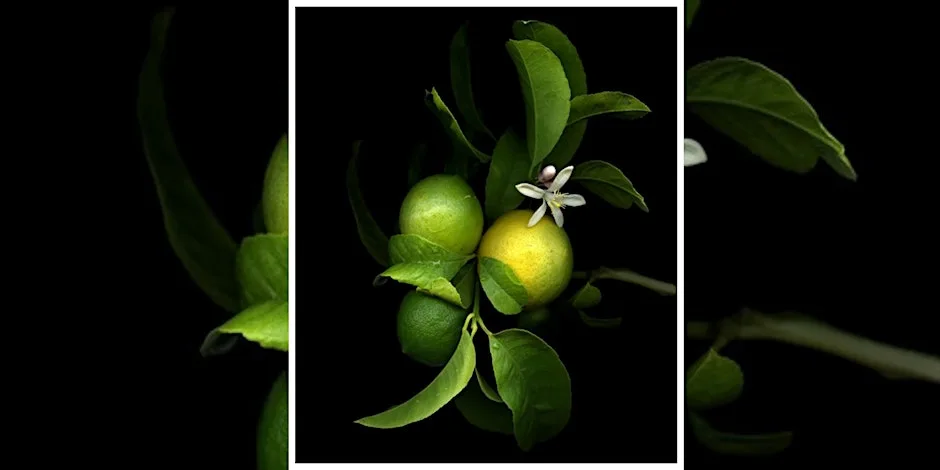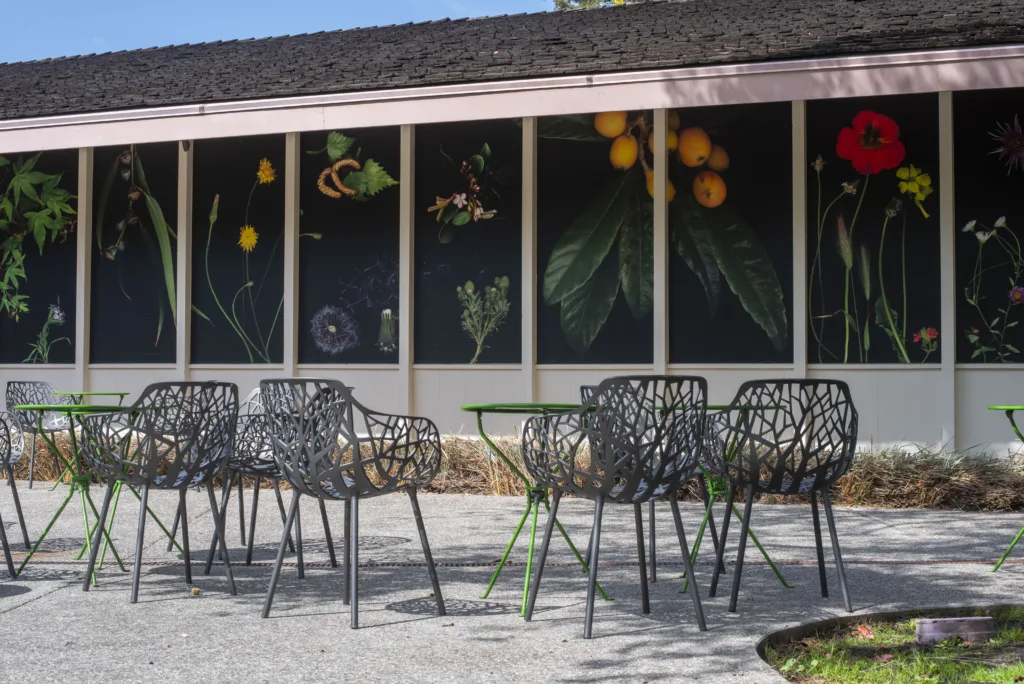This podcast is also available on Spotify, and Apple Podcast.
Interview Transcription
Hi. My name is Kija Lucas. I’m an artist working in photography and installation, and my exhibition at the Palo Alto Art Center is The Enchanted Garden.
The Enchanted Garden was the name of my father’s gardening business. He had a gardening business when I was a kid, where my brothers and I would go with him to work on days that we had off from school, or either maybe if we were just a little bit sick but not so sick, we had to stay in bed, and we would go with him to work and weed in other people’s yards. Sometimes help him plant plants and go to the nursery with him, and then otherwise watched him laying sod or trimming trees or whatever he had to do in their yard.
So the exhibition is in several parts. There’s a large, I’ll call it a mural piece in 36 parts on the front windows of the Palo Alto Art Center. It’s about 20 by 13 feet, and it has both botanicals and trees that reminded me of Palo Alto, as well as other people who I asked who grew up here or spent time in Palo Alto.
The inside of the gallery, there’s an alcove that will have wallpaper that I designed with lemons that are both ripe and unripe, and then blossoms. I love the way that citrus is constantly in all different stages of growing in the bay. And then on top of that, will be images of rusty tools hung in ornate frames. The tools sort of are calling into the labor of like what it takes to make a garden.
Between the alcove and the glass gallery will be an altered map of Lawrence Lane, which is the cul-de-sac I grew up in and where my father’s house was. Lawrence Lane was an intentionally integrated street that was conceived in the late 40s and built in the 50s; in the height of redlining, there were black families, Asian families, and white families, and it kind of helped me as a mixed-race kid, to see families of other races and also other black families on our street.
Also, thinking about it, I always thought it was like such an ideal thing, and talking to my brother, who’s studying it for his dissertation, like I’m learning more about the respectability politics that go into creating an intentionally integrated community in that time, and also probably today, it was at the height of redlining. And so when the people who were involved in this, what they called an experiment, were going to the neighbors to ask their permission, and had to go to the city to ask permission to create this cul-de-sac.

And then, going into the glass gallery, there is on the walls the entire gallery, other than the brick, will be wrapped in also wallpaper that I designed, which will be transitioning through the room, kind of like a garden transition as you see different plants growing in different places. It gets a little bit thicker over time; certain plants are added, and others are taken away.
There’s a bit of a compulsion to organize in the way that I feel like humans often have this impulse, especially like this colonial impulse, to like organize nature, whether it be in our garden or whether it is in science books and the way that we study the other than human world.
And then, on top of that wallpaper will be botanicals that remind me of Lawrence Lane or of growing up in Palo Alto: the sour grass that I used to chew as a kid or a pine tree that I used to climb in my neighbor’s yard.
Lemons come up a lot in my work because it reminds me of sitting on my dad’s front porch when he would smoke when I was a kid. He smoked indoors until I was in the second grade and then moved out to the porch. So, if we wanted to spend time with him, it was out there.
I include both Indigenous and misplaced botanicals and trees because I feel like the way that we discuss botanicals is very similar to the way that we discuss groups of people. The idea of invasive and native, and not really thinking of how those botanicals arrived. Why they’re often maligned and so those are all sort of mixed together in the wallpaper, and then also on top of it.
I think The Enchanted Garden is, at the same time, the most personal work I’ve ever made, but also the most impersonal work at the same time; it’s so much digging into my own childhood, my own feelings about growing up in Palo Alto, about being in a place where I never felt like I fit, and being a place that had expectations of me that I didn’t understand existed until long after I could have possibly met them.

I like, that’s one of the other reasons why I was interested in bringing in the like, misplaced botanicals. I felt like, always like, I stuck out like a sore thumb here. I didn’t quite know how to act. I didn’t quite know or have the money to dress in order to fit in, or, like, wear the uniform of, like, the place. I was kind of a weird kid, which, as an artist, I appreciate that, and I feel like it’s fine, but it’s so uncomfortable growing up being like undiagnosed ADHD, like, not understanding why I don’t fit into, like, the academic expectations.
That’s another reason why I wanted to name the show Enchanted Garden; beyond, like, naming it after my dad’s business, I feel like an enchanted space is something that has a spell on it that makes you think it’s one thing. When you’re in it, then you realize maybe that it’s something else. And I felt like that was a really important thing to bring into it, because I feel like that kind of is how I feel about Palo Alto.
I’m trying to learn how to claim having grown up here, but a lot of times when people say, like, Oh, you’re from the Bay Area. Like, where did you grow up? I’ll say the South Peninsula because I feel like when I say Palo Alto, there’s an assumption about growing up in Silicon Valley. There’s an assumption that, like, my family was in tech, or like, you must be super wealthy, and that’s just not the way that I grew up. I grew up like, like I said, with my hands in the dirt, like digging weeds out of other people’s yards.
With my work, I’m bringing in things that are beautiful, like I want them to be, almost stunning to look at. I think of a photograph as a great place to lie, as a place to like, where we put our truths. So I have this sort of, I use a little bit of a scientific visual tropes, like using the black background, having something with so many details in it. I do not, I on purpose, do not use perfect specimens of everything. I want us to think about all of these things as being beautiful and useful.
But one of the things that I want to do with my work is to draw people in, so then we can have the more difficult conversation, like, how do we think about these plants, and how does that translate to how we think about people? How do we treat these botanicals, and how does that translate to how we treat other people? And where does that come from?
Like, the same scientists that were categorizing plants were categorizing people, and this like way of like, I’m reading this book right now where the author talks about how the most plant specimens from around the world are from Europe, where they don’t have the most plant specimens. And so, people who are from nations or lands where these plants are indigenous to might not be able to study them because they’re not there for them to study.
So I feel like, how did these botanicals also talk about migration? How do they talk about the way that people have been interacting with the land over the years? Especially since the bay or the US was colonized; that interaction with botanicals, the bringing of the eucalyptus, but also the olive tree, which is like this symbol of wealth, or the Magnolia, I was learning recently is also a symbol of wealth. They planted magnolia trees here, but they’re like, they take so much water to keep them alive, and but we do it, and it’s like this thing that says, like, okay, cool. I have enough money to keep this beautiful tree, which might be the oldest flower in the world, alive.
So all of those things are sort of in there, but I want to draw people in. I want your grandmother to be able to walk into the exhibition and be like, Okay, I can get something out of it. And your grandma might be, like, super into these political conversations, but maybe not. Maybe she sees something, and then she reads a little something and then thinks about the world a little bit differently. I’m not out here to like, I’m not an activist. I’m not out here to change the world, but I do want to give a space for people to maybe have a different perspective on things.
List of events related to GROW and The Enchanted Garden Exhibitions
- Opening: GROW, Friday Night, Sept. 20th 6p – 8p
- Panel Discussion Sunday, Nov. 10th, 2p -3:30p
- Workshop Sunday, Dec 8th. 2p -3:30p

